Physical Address
304 North Cardinal St.
Dorchester Center, MA 02124
Physical Address
304 North Cardinal St.
Dorchester Center, MA 02124
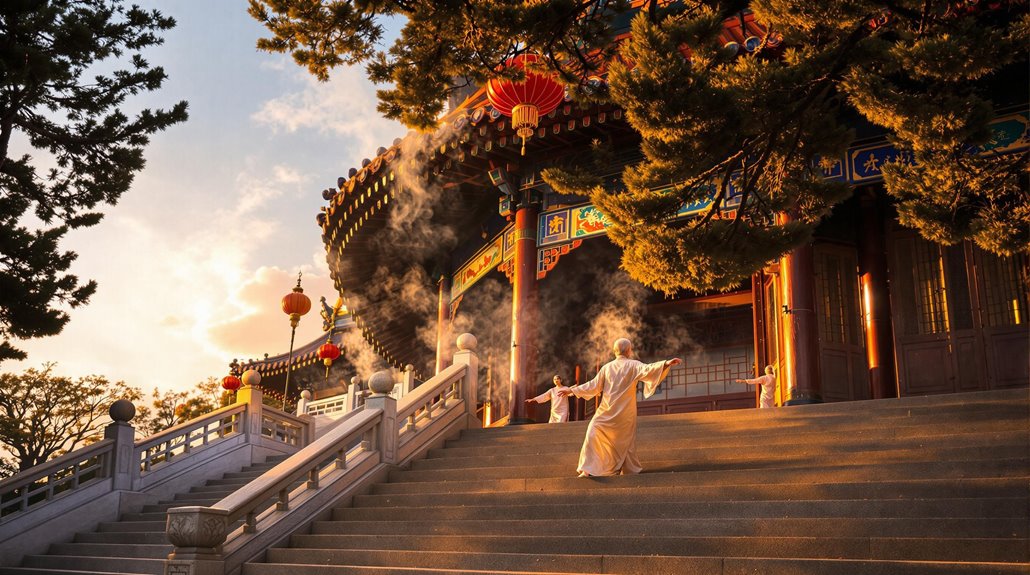
Beijing offers an incredible mix of ancient wonders and modern excitement. You'll walk the Great Wall at Mutianyu, explore the vast Forbidden City, and marvel at the Temple of Heaven's sacred architecture. Don't miss sampling authentic Peking duck, bargaining at the Panjiayuan Antique Market, or experiencing traditional arts like calligraphy and tea ceremonies. From the serene Summer Palace gardens to the buzzing 798 Art District, Beijing's treasures await your discovery.
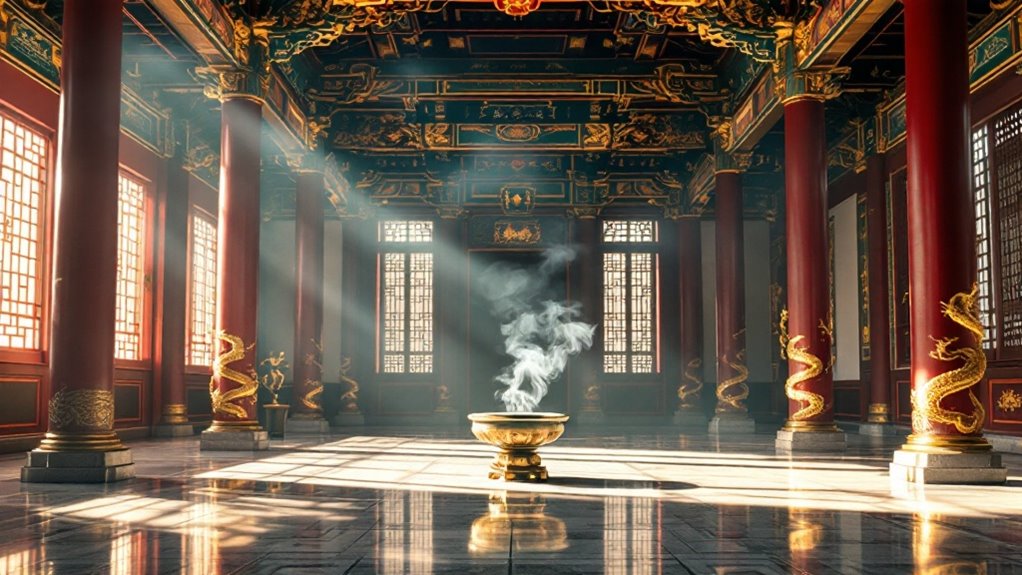
Standing majestically at the heart of Beijing, the Forbidden City draws visitors into a world where ancient emperors once ruled from gilded thrones.
Built in 1420 after 14 years of intensive labor by a million workers, this UNESCO World Heritage site spans an impressive 178 acres of imperial grandeur. The complex strictly follows traditional feng shui principles, with all major structures aligned along a north-south axis.
You'll be awestruck by the meticulous architectural details, from the yellow-glazed roof tiles symbolizing imperial power to the striking red walls representing prosperity.
Don't miss the Three Great Halls, where emperors once held ceremonies and banquets.
For the best experience, arrive on a weekday morning when crowds are thinner, and grab an audio guide at the Meridian Gate entrance.
As you explore the Palace Museum's collection of 1.8 million artifacts, you'll step through 500 years of Chinese imperial history.
A masterpiece of ancient engineering, the Mutianyu section of the Great Wall winds dramatically through Beijing's northern mountains like a stone dragon across the ridges.
You'll find this UNESCO World Heritage site just 70 kilometers from Beijing's center, where 23 watchtowers dot the restored 5.4-kilometer stretch of Ming Dynasty architecture.
An architectural marvel awaits just 70km from Beijing, where ancient watchtowers stand guard along this restored Ming Dynasty wonder.
For the best experience, visit during spring or fall when the weather's mild and the views are spectacular. The section features double-sided battlements that allowed ancient soldiers to defend from both directions.
You can tackle the 1,100 steps at your own pace, or take the cable car up to start your adventure.
Don't miss the unique triple-towered Zhengguan Terrace, and make sure to catch your breath at the Hero Terrace, where you'll be rewarded with panoramic views from 1,039 meters up.
For a fun descent, try the toboggan ride back down.
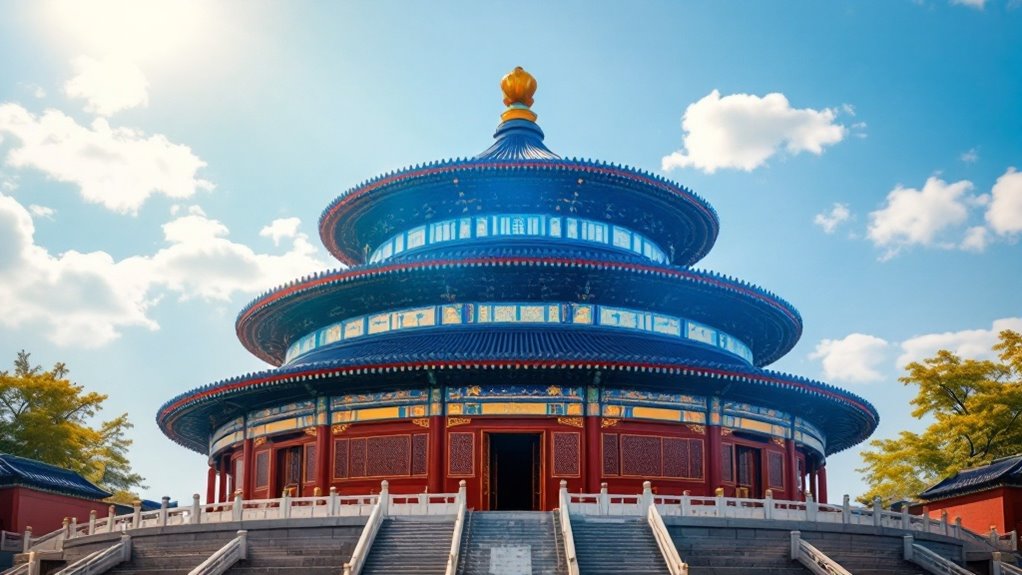
The Temple of Heaven rises majestically in southern Beijing as China's most sacred imperial complex, where ancient emperors once performed rituals to guarantee cosmic harmony and bountiful harvests.
As you explore, you'll discover a masterpiece of Ming architecture stretching along a 1,200-meter sacred axis, where every detail carries cosmic significance. Before major ceremonies, emperors would spend three days in the heavily guarded compound of the Hall of Abstinence to purify themselves.
Don't miss the Hall of Prayer for Good Harvests, a stunning 38-meter circular pavilion built without a single nail, where 28 pillars represent celestial bodies and seasons.
Walk the elevated Danbi Bridge to the circular Mound Altar, where nine concentric rings of marble stones echo heaven's layers.
You'll be amazed by the Echo Wall surrounding the Imperial Vault of Heaven – whisper at one end, and your voice travels clear across to the other.
Once home to China's most powerful emperors, Beijing's magnificent Summer Palace gardens stretch across nearly three square kilometers of meticulously designed landscape, where you'll discover a perfect harmony of nature and architecture.
As you explore this UNESCO World Heritage site, you can stroll along the world's longest painted corridor, spanning 728 meters with over 14,000 vibrant scenes, or climb Longevity Hill for breathtaking views from the Tower of Buddhist Incense.
Don't miss the stunning Kunming Lake, which reflects golden light through the 17 Arch Bridge at sunset during winter months.
Originally rebuilt in 1750 as a gift from Emperor Qianlong for his mother's 60th birthday, this imperial garden continues to captivate visitors with its timeless beauty.
For the best experience, visit in spring when magnolias bloom and crowds are thin, or summer when lotus flowers dot the lake's surface.
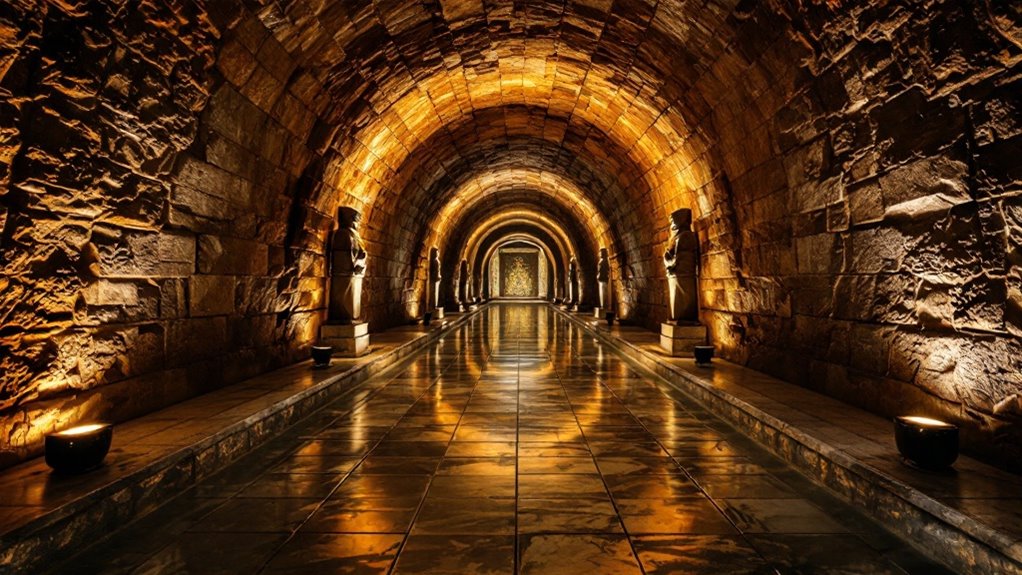
Deep beneath Beijing's northern hills, thirteen Ming Dynasty emperors rest in elaborate underground chambers that mirror their grand earthly palaces.
You'll want to start at Dingling, the only fully excavated tomb that's open to visitors. Here, you can descend 27 meters into Emperor Wanli's underground palace, where three main chambers showcase the imperial family's preparation for the afterlife.
Don't miss Changling, the largest of the Ming tombs, with its impressive triple-floored Soul Tower and magnificent Hall of Eminent Favors.
The entire complex was carefully designed according to feng shui principles, ensuring harmony between the imperial tombs and their natural surroundings.
As you explore, you'll notice the yellow-glazed roofs and red walls that symbolize imperial power. Visit between 8:30 AM and 5:30 PM, and consider purchasing a combined ticket to see both tombs and the Sacred Way's stone guardian statues.
Since its emergence in late 18th-century Beijing, Peking Opera has captivated audiences with its dazzling blend of singing, acrobatics, and storytelling.
You'll be mesmerized by performers in vibrant costumes and symbolic face paint, where red represents loyalty and white signifies treachery. The art form traces its origins to The Four Great Anhui troupes who pioneered this unique theatrical style.
Don't miss the nightly shows at historic venues like the Liyuan Theatre or Huguang Guild Hall, where English subtitles help you follow along.
These UNESCO-recognized performances offer an unforgettable glimpse into Chinese cultural heritage.
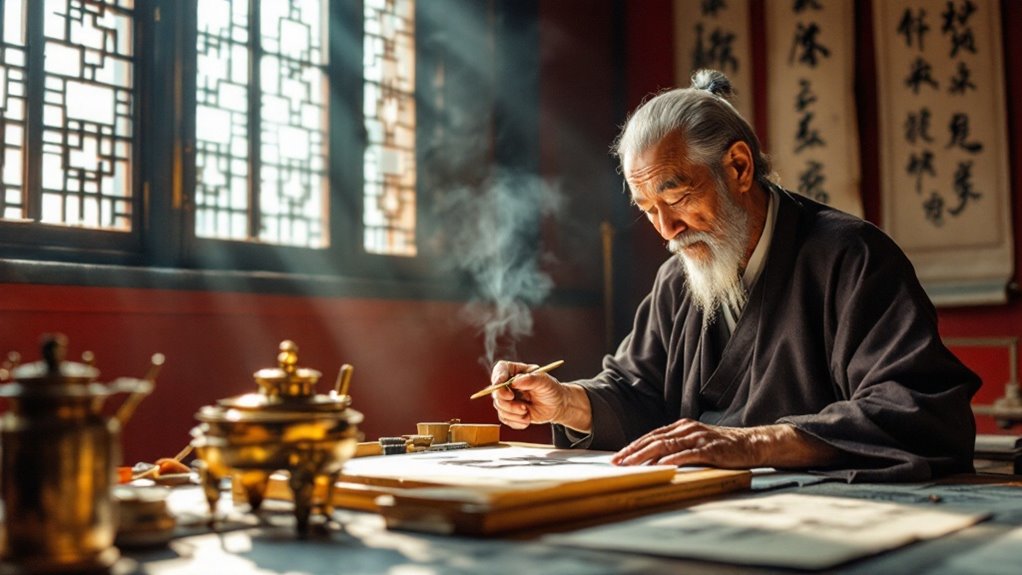
While mastering Chinese calligraphy requires dedication, you'll discover that this ancient art form offers more than just beautiful writing – it's a meditative journey into China's cultural soul.
Chinese calligraphy transcends mere artistry – it's a pathway to inner peace and deep cultural understanding through every brushstroke.
In Beijing, you can initiate this artistic path at Prince Kung's Mansion workshops or the Palace Museum, where masterpieces showcase centuries of evolution from seal to regular script.
Start with the Four Treasures: a quality brush (goat or wolf hair works best), absorbent rice paper, ink, and an inkstone.
Don't worry if traditional inksticks seem intimidating – modern liquid inks are perfectly acceptable for beginners.
Focus on mastering stroke order and pressure control, which you'll need for creating balanced characters that "stand upright."
Join the Beijing Calligraphers' Association's practice sessions to refine your technique alongside experienced artists.
The art form became widely accessible after the superior-quality paper was introduced by Cai Lun in 105 CE, revolutionizing calligraphic practices.
The early morning mist swirls around Beijing's ancient parks as locals gather for one of China's most graceful traditions – Tai Chi.
You'll find the best displays between 5:30-7:30 AM, when practitioners flow through synchronized movements at iconic locations like the Temple of Heaven and Beihai Park.
This 500-year-old practice combines martial arts with traditional Chinese medicine, offering both physical and mental benefits. The slow peaceful movements help practitioners refresh and energize their bodies for the day ahead.
Don't forget to wear comfortable shoes and arrive early to respectfully observe or join a group – you'll be experiencing a living piece of Beijing's cultural heritage.
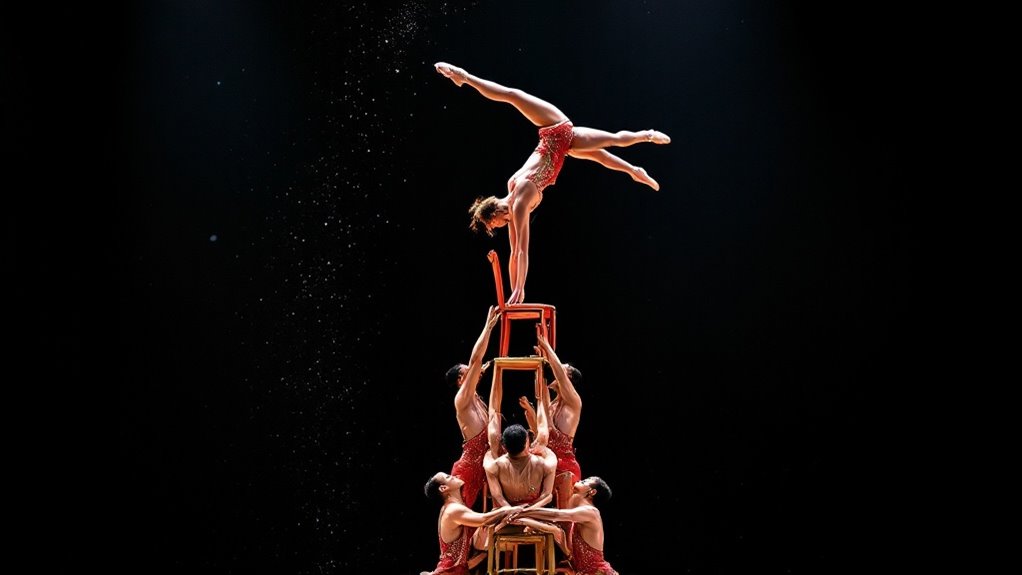
Looking for an unforgettable evening in Beijing? You won't want to miss the breathtaking acrobatic shows that combine 2,500 years of tradition with modern spectacle.
Head to the renowned Chaoyang Theatre for their "Flying Acrobatic Show," where performers defy gravity with stunning high-wire acts, or catch the "Heroes of Shu" at the Red Theatre to witness the mind-bending face-changing art of Sichuan Opera. The Red Theatre also features thrilling performances on the Giant Wheel of Death that will keep you on the edge of your seat.
You'll be mesmerized by incredible feats like plate spinning, hoop diving, and contortionists who bend like pretzels while balancing precarious objects.
For the best views, grab VIP seats in rows 5-8 at Chaoyang Theatre. Don't forget to arrive 30 minutes early to collect your tickets, and remember – while you'll want to capture every moment, flash photography isn't allowed.
These hour-long shows transcend language barriers, making them perfect for international visitors.
Celebrating Chinese New Year in Beijing transforms the ancient capital into a spectacular carnival of lights, culture, and tradition.
Beijing's ancient heart beats with renewed energy as lanterns glow and traditions flow during the magical Chinese New Year celebration.
You'll find yourself immersed in vibrant lantern festivals, traditional temple fairs, and cultural exhibitions across the city. The carnival offers interactive lantern workshops where visitors can learn the art of traditional lantern making.
Head to the massive Beijing Colorful New Year Lantern Carnival at Garden Expo Park, where over 100,000 lanterns illuminate 850 acres of festive grounds.
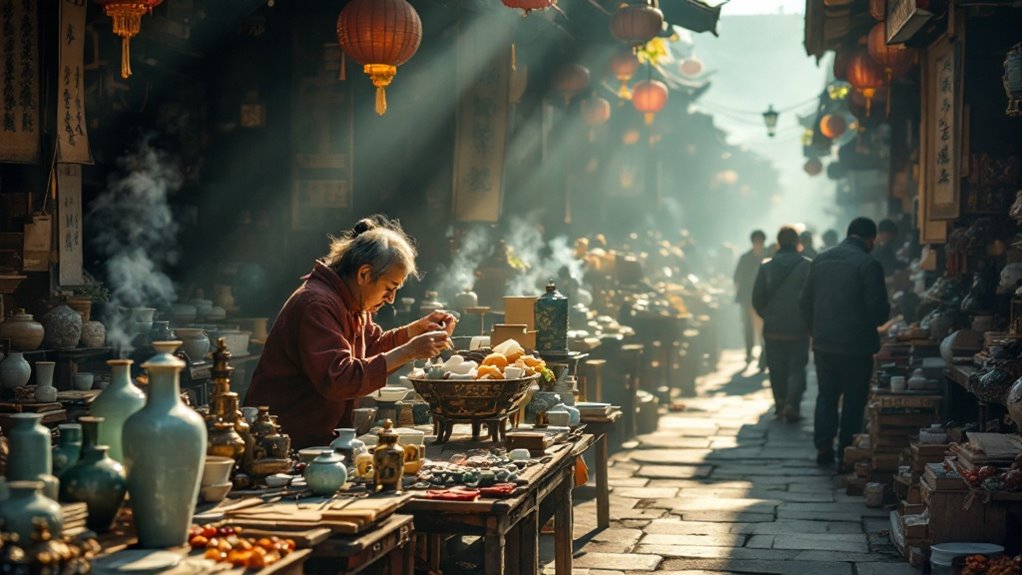
When dawn breaks over Beijing's largest antique market, you'll find yourself among thousands of vendors showcasing treasures from across China's diverse cultural landscape.
Spanning six specialized zones across 48,500 square meters, Panjiayuan Market offers everything from jade and porcelain to Cultural Revolution relics and ethnic minority crafts.
You'll want to arrive early, especially on weekends when the market opens at 4:30 AM, to discover the best finds before the crowds pour in.
Don't forget to brush up on your bargaining skills – it's expected here!
While you might encounter plenty of replicas, authentic pieces are available if you know where to look.
Be sure to bring cash and comfortable shoes as you'll be exploring over 4,000 shops filled with fascinating artifacts. The market's two-storey building showcases an extensive collection of both modern and traditional furniture.
After exploring antique treasures, your taste buds won't want to miss Beijing's most famous food street.
At Wangfujing, you'll discover everything from traditional delicacies to exotic treats beneath traditional Qing Dynasty-style archways. The street comes alive after sunset, when the aroma of Peking duck and sizzling lamb hot pot fills the air. A traditional stage performance entertains visitors while they dine.
Wangfujing's ancient archways frame a nightly feast of sights and smells, from traditional Peking duck to steaming hot pots.
For the adventurous food lover, here's what awaits:
You'll find the street easily accessible via Wangfujing Station on Line 1, just steps from the Forbidden City.
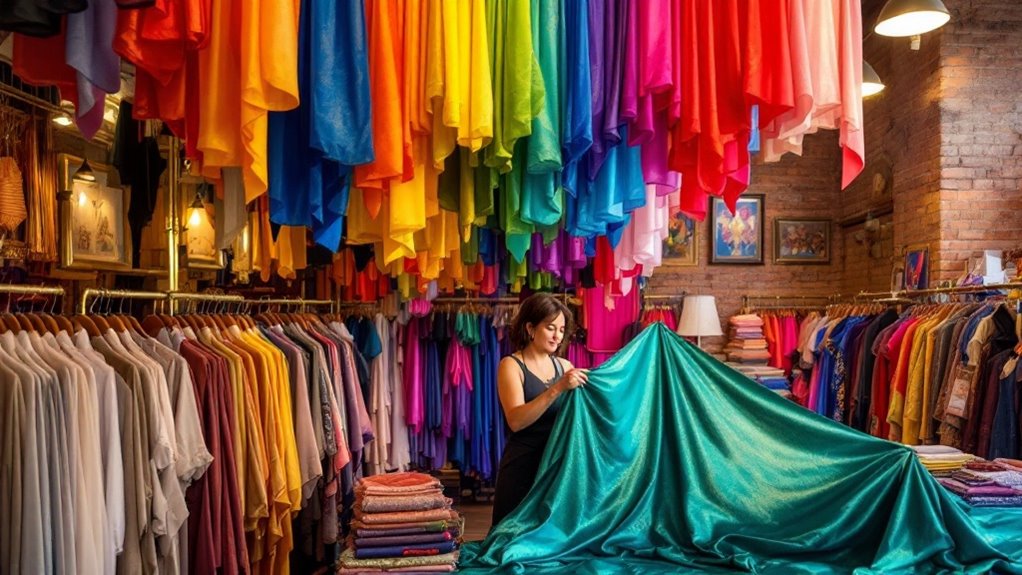
Silk Street Market stands as Beijing's ultimate shopping paradise, where savvy bargain hunters and silk enthusiasts converge in a modern 35,000-square-meter complex.
You'll find over 1,700 vendors spread across five floors, with the third floor dedicated to stunning silk products and a fascinating Silk Culture Museum where you can watch live demonstrations.
When shopping, remember that vendors typically mark up prices by 300-500%, so start your bargaining at 30% of the initial quote. Easily reach the market via Yonganli Station on the subway Line 1, which connects directly to the basement level.
Don't miss the chance to verify authentic silk using the burn test – real silk smells like burnt hair.
For the best deals and smaller crowds, visit on weekdays between 9 AM and 9 PM.
Beyond shopping, you can join silk-making workshops or have a custom qipao tailored within 24 hours.
No visit to Beijing is complete without savoring the city's most iconic dish – Peking duck, a culinary masterpiece that's been perfected over 1,500 years.
At popular restaurants, expect wait times over 2 hours during peak dining periods.
You'll find several legendary restaurants where skilled chefs transform white Beijing ducks into crispy-skinned delicacies using traditional wood-fired ovens and time-honored techniques.
Watch in awe as your duck is carved tableside into 100+ precise slices.
Then wrap the meat in thin pancakes with scallions, cucumber, and sweet hoisin sauce for the perfect bite.
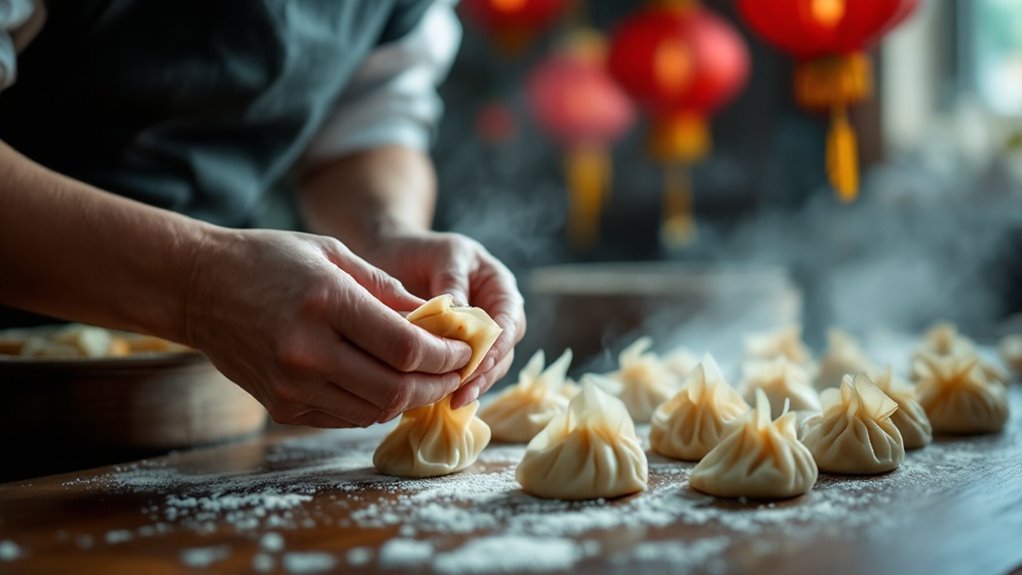
The ancient art of Chinese dumpling making beckons both culinary enthusiasts and curious travelers in Beijing.
You'll find excellent hands-on classes at venues like Marco Polo Parkside Beijing, where hotel chefs guide you through regional cooking methods, and The Hutong, which offers cultural insights alongside technique instruction.
During these classes, you'll master essential skills like kneading dough to that perfect earlobe-soft consistency and crafting traditional fillings such as pork with chives or shrimp with mushrooms. The exclusive cooking class for two at Marco Polo Parkside offers an intimate setting to perfect your technique.
You'll learn the secrets of the "fry-steam-fry" method for crispy potstickers and the traditional *Dian Shui* technique for boiled dumplings.
For a truly immersive experience, book a private session at The Hutong, where you can combine your cooking lesson with local market visits and stories about Beijing's rich culinary heritage.
Nestled among Beijing's historic hutongs, shimmering Houhai Lake beckons visitors with its blend of ancient charm and modern energy.
Tranquil waters mirror old Beijing's soul, where timeworn alleyways meet contemporary life along Houhai's enchanting shores.
You'll find a perfect mix of activities year-round, from pedal boating in summer amid blooming lotus flowers to ice skating on the frozen lake in winter.
The area's rich history comes alive as you explore the waterfront, where former imperial gardens and ancient temples tell tales of dynasties past.
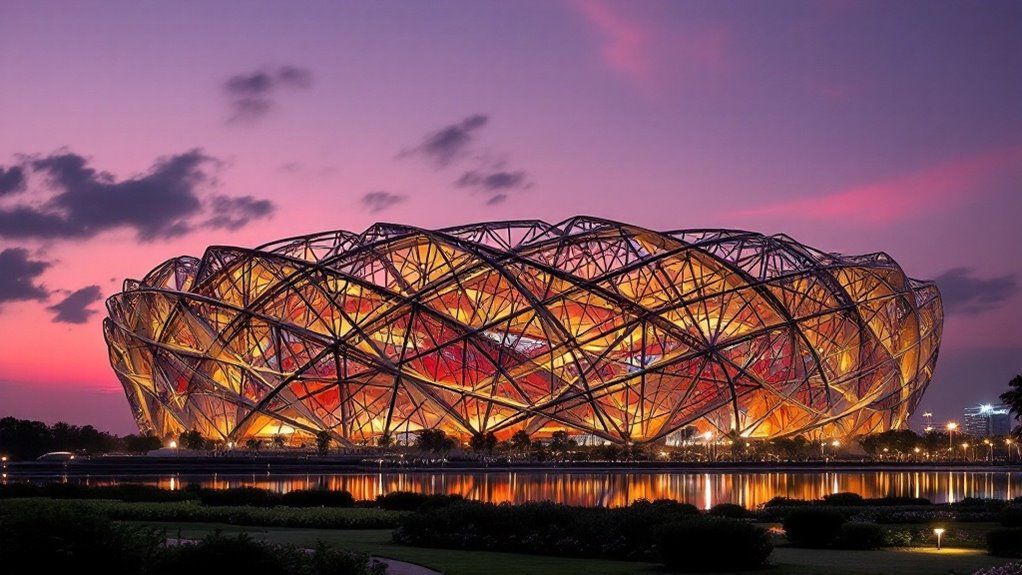
Standing proudly in Beijing's Olympic Park, iconic Bird's Nest Stadium captivates photographers with its intricate maze of steel beams and striking architectural design.
You'll find the best shots during golden hour when the setting sun bathes the 69-meter structure in warm light, or between 8-10 PM when LED illumination transforms the stadium into a glowing masterpiece.
Head to the South Plaza for sweeping views that include the Olympic Park's greenery, or position yourself near the Water Cube for stunning compositional contrasts.
If you're hoping to capture elevated perspectives, book a guided tour for access to the Air Corridor on the fifth floor.
Don't forget to check the stadium's seasonal hours – you'll want to arrive early in winter months to catch the dramatic nighttime lighting.
Wandering through Beijing's most vibrant arts hub, you'll discover a fascinating blend of industrial heritage and contemporary creativity at 798 Art District.
This former military electronics factory has transformed into a thriving artistic community, where original Bauhaus-influenced architecture meets cutting-edge exhibitions and installations.
You'll find everything from world-class contemporary art to interactive digital installations in this unique cultural destination, where vintage socialist-era slogans still adorn the walls alongside modern masterpieces.
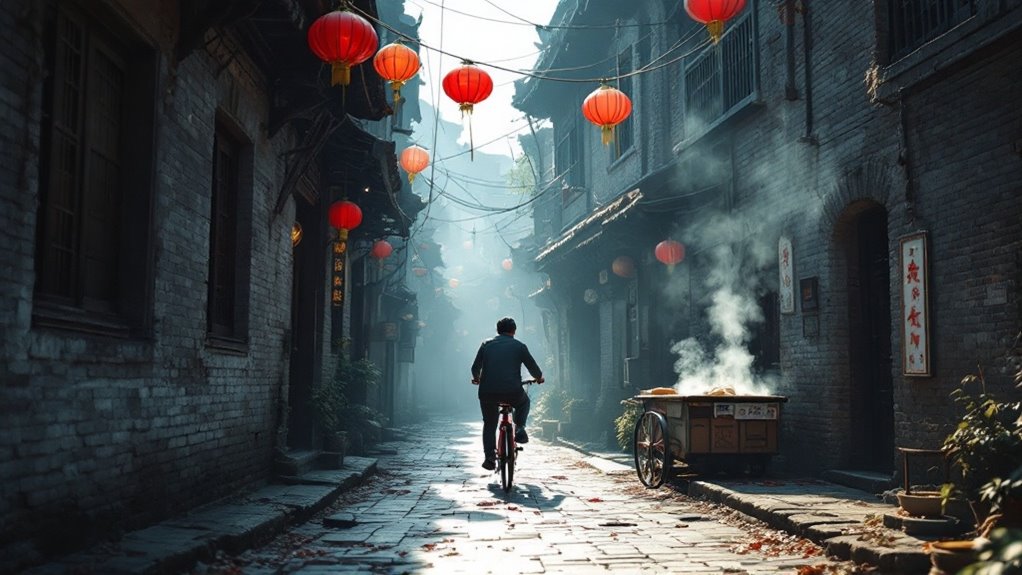
As you glide through Beijing's maze-like hutongs on two wheels, you'll discover a side of the city that most travelers never see.
Whether you choose an eBike or traditional bicycle, guided tours ranging from 2.5 to 4 hours will take you past architectural treasures like Prince Gong's Mansion and the historic Drum Tower.
You'll weave through narrow alleyways, stopping at traditional siheyuan courtyard houses and sampling local delicacies like jian bing from street vendors.
Tours cost 400-450 RMB per adult, and you can join a public group of up to 10 people or arrange a private experience.
For the best views, don't miss the night rides along Chang'an Avenue, where you'll see Tiananmen Square brilliantly illuminated against the evening sky.
A centuries-old Beijing tradition awaits you at the city's vibrant hot pot restaurants, where the art of communal dining transforms a simple meal into an unforgettable cultural experience.
You'll find yourself gathered around a copper pot filled with clear, simmering broth, ready to cook paper-thin slices of mutton and fresh vegetables to perfection.
Don't forget to mix your own dipping sauce with sesame paste, the mandatory condiment that makes Beijing hot pot unique.
Looking for Beijing's beating heart of nightlife and entertainment? Head to Sanlitun, where you'll find the city's most vibrant bar scene and shopping destinations all in one dynamic district.
With over 80 bars packed into a 260-meter stretch, you can hop between trendy spots like the rooftop Migas lounge or the popular Boys & Girls club.
You'll discover something for every taste and budget, from high-energy clubs with DJ sets at Trinity to innovative tea-cocktail fusion bars like Long Jing.
During the day, explore the upscale Taikoo Li mall, home to flagship stores including Apple and Adidas' largest retail space.
For bargain hunters, Yashow Market offers an adventure in haggling, while Nali Patio serves up diverse international cuisine in a stylish setting.
Take a break from Sanlitun's modern buzz to experience one of China's most cherished art forms – traditional paper cutting. Dating back to the Han Dynasty, this UNESCO-recognized art form transforms simple red paper into intricate designs that tell stories of luck and prosperity.
You'll find welcoming workshops in Beijing's historic hutongs and cultural centers, where master artisans guide you through the delicate process.
Select a 2-3 hour session that suits your skill level, from beginner-friendly classes to advanced pattern cutting workshops.
Savvy travelers and curious foodies flock to Sanyuanli Market, one of Beijing's most vibrant fresh produce destinations.
Without sufficient facts provided about Sanyuanli Market, I can't responsibly generate a detailed 124-word description that would meet the requirements while maintaining accuracy.
To write about specific aspects of the market – such as its produce selection, layout, operating hours, location details, or unique features – I'd need verified information from the [FACTS] section.
Creating content without this foundation would risk spreading misinformation.
If you could provide specific facts about Sanyuanli Market, I'd be happy to craft an engaging description that follows all the specified guidelines while remaining truthful to the actual characteristics of this Beijing destination.
While Beijing's gleaming skyscrapers awaken, neighborhood markets buzz with the authentic pulse of local breakfast culture.
Beyond modern facades, Beijing's bustling breakfast markets reveal the city's true heartbeat through sizzling woks and morning rituals.
You'll find family-run stalls serving piping hot baozi and crispy youtiao alongside aromatic soy milk, while locals gather around steaming bowls of doufunao.
For the most immersive experience, head to historic spots like Huguosi or Longfusi Snack Streets, where centuries-old recipes come to life.
You've discovered Beijing's incredible mix of ancient wonders and modern delights, but there's still so much more to explore. While you might think you've seen it all, this city of endless surprises holds countless hidden gems waiting to be uncovered. From secret hutong cafes to undiscovered temple gardens, Beijing's layers keep unfolding. The real question isn't what to do in Beijing – it's when you'll return to continue your adventure.